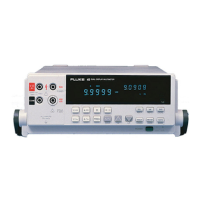Option -01 Battery Pack
Theory of Operation
7
7-5
7-5. Switching Power Supply
The switching power supply regulates the output voltage with a pulse-width modulating
technique that varies the on time of the FET switch, Q5. The controller chip for this
process (U4) contains the required 1 V reference, switching oscillator, regulator
comparator, current limit comparators, and output switch. The controller chip is
supported by several external components: C7 sets the oscillator frequency; R17, C6,
and C8 are required for stability; R15, R21, and R20 set the output voltage level. The
variable-width pulse from U4-5 is first level-shifted and clamped by R23, R24, and CR7
and then coupled to the FET switch circuit through inverter U3-2. Hex inverters U3-4,
U3-6, and U3-10 are connected in parallel to provide sufficient drive to the FET gate.
FET switch Q5 is turned on at the beginning of each square wave drive cycle and turned
off at the point necessary to set the desired output voltage.
The current limit is set by the voltage drop across the 0.1-ohm resistance provided by the
parallel configuration of five 0.5-ohm resistors (R29, R34, R35, R36, and R37). Current
limiting occurs when the voltage drop across the ohm resistance is greater than
approximately 100 mV. Current limiting is effected by reducing the duty cycle of the
switching transistor, Q5, which in turn reduces the output voltage of the supply.
A bootstrap supply for the driver and coupling/clamp circuits is provided by CR8, R25,
C9, C11, VR3. The output level has a negative temperature coefficient to provide the
proper charging voltage level for the battery pack over a broad temperature range. This
negative coefficient is provided by the Temperature Compensation circuit (Q4, R18, and
R19) in the feedback path of the switching power supply.
7-6. Cycle/Float Charge Rate Switch
The Cycle/Float Charge Rate Switch monitors the charging current supplied to the
battery pack during charge when the meter is de-energized. If the current is 60 mA to 80
mA or higher, the charging voltage is increased to about 9.8 V. This level of current
causes a voltage drop across R28 that is sufficient to turn Q6 and Q7 on, connecting one
end of R22 to common. The resulting current through R22 modifies feedback to the
switching supply, causing the increased output voltage.
As the battery pack charge reaches about 90% of capacity, the charge current at 9.8 volts
drops below 60 to 80 mA; Q6 and Q7 turn off, and the charging voltage decreases to
9.35 volts, the trickle charge level for the battery pack. Diode CR10 clamps the voltage
across R28 to about 0.8 V maximum.
7-7. Low Battery Indicator Detector
The Low Battery Indicator Detector uses comparator U2-7. Bandgap reference VR2 is
connected to the inverting input of the comparator, while the divided-down battery
voltage is connected to the noninverting input. Resistor R16 provides the comparator
with a hysteresis of approximately 0.25 V.
The comparator output is an open collector transistor connected to pull-up resistor R45
on the Main Circuit Assembly. When the battery pack voltage falls below about 7.7 V,
U2-7 goes low. When the battery pack voltage rises above about 8.0 volts, U2-7 goes
high. If the battery pack option is not installed, the pull-up resistor on the Main Circuit
Assembly pulls the battery line high to keep the low battery indicator turned off.
7-8. Low Battery Disconnect
The Low Battery Disconnect uses FET switch Q2. The FET gate is driven by a latching
circuit comprised of Q3, Q12, Q13, and VR4.

